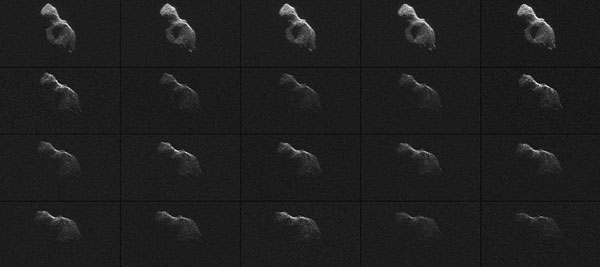NASA announces a meteorite image
On June 16, the US Space Agency (NASA) announced images of a giant meteorite, nicknamed 'monster', flying over Earth at a relatively close distance.
The 2014 HQ124 meteorite flew over Earth at a distance of 1.25 million km on June 8, but did not cause any effect. Two scientists Marina Brozovic and Lance Benner at NASA's Jet Propulsion Laboratory in California (USA) used radar observation stations to record 21 clear images of this meteorite over 4 hours.

Images of the 2014 meteorite HQ124 published by NASA on June 16.(Photo: icyscience.com)
Mr. Lance Benner said that the 2014 meteorite HQ124 seems to be an elongated object with a size of about 370m. With this length, scientists believe that the meteorite dubbed the 'monster' can cause an explosion that can destroy millions of tons and wipe out a city, if it plunges to Earth.
'This could be a double meteorite, consisting of two celestial bodies that form an asteroid with an elongated shape , ' said astronomer Lance Benner.
Astronomers began to care about the 2014 HQ124 meteorite, discovered from April 23, before it flew over Earth at the nearest distance on June 8 last. Meteors have a flying speed in space of 50,400km / hour.
'HQ124 is at least 10 times larger and maybe 20 times more than a meteorite, causing thousands of people to be injured last year in Chelyabinsk, Siberia, Russia,' said astronomer Bob Berman of the Slooh Space Telescope Center. said. 'If it collides with our planet, the energy emitted will not be the same as the atomic bombs used in the end of World War II, which is equivalent to the millions of tons of H bombs'.
- NASA announces unpublished Earth image
- 5 NASA steps dealing with meteorites crash into Earth
- NASA announces the sharpest image of Pluto's surface
- NASA discovered a large meteorite heading towards Earth
- NASA announces beautiful galaxy image
- The map shows that Earth is continuously attacked by meteors
- NASA announces the best satellite image in 2011
- NASA announces the latest image of Jupiter
- NASA admits helplessness against meteors
- NASA announces super-stormy image of Big Red Spot on Jupiter
- Russia wants to
- The meteorite is smooth as if it was ground on Mars
 Van Allen's belt and evidence that the Apollo 11 mission to the Moon was myth
Van Allen's belt and evidence that the Apollo 11 mission to the Moon was myth The levels of civilization in the universe (Kardashev scale)
The levels of civilization in the universe (Kardashev scale) Today Mars, the sun and the Earth are aligned
Today Mars, the sun and the Earth are aligned The Amazon owner announced a secret plan to build a space base for thousands of people
The Amazon owner announced a secret plan to build a space base for thousands of people Without diamonds or gemstones, this watch still costs nearly 6 billion VND, listed in Guinness for its unique record
Without diamonds or gemstones, this watch still costs nearly 6 billion VND, listed in Guinness for its unique record  A giant meteorite once crashed into Earth, 200 times larger than the meteorite that wiped out the dinosaurs.
A giant meteorite once crashed into Earth, 200 times larger than the meteorite that wiped out the dinosaurs.  Detection of never-before-seen 'pre-solar particles' falling in Antarctica
Detection of never-before-seen 'pre-solar particles' falling in Antarctica  Plan to 'catch' meteorites with giant magnets
Plan to 'catch' meteorites with giant magnets  430 km long field filled with meteorites
430 km long field filled with meteorites  Spherical, prismatic 'foreign object' exposed in meteorite that fell to Russia
Spherical, prismatic 'foreign object' exposed in meteorite that fell to Russia 